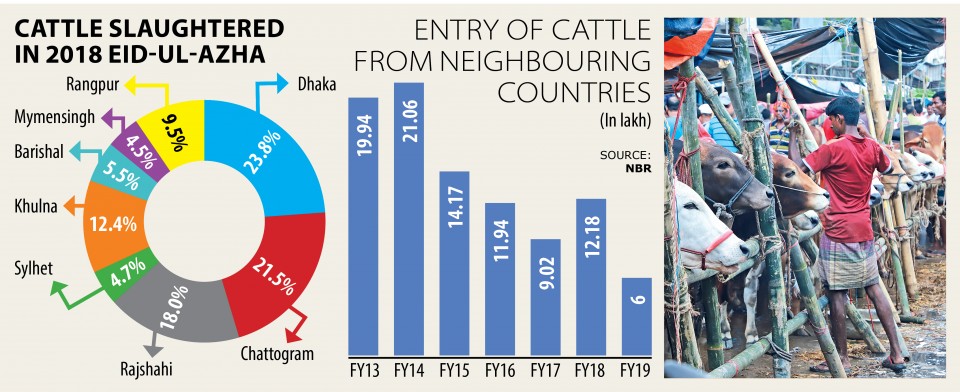Entry of Indian cattle drops to a four-year low

Informal entry of cattle, mainly from India, has dropped significantly in the face of strict vigil by law enforcement agencies of the neighbouring country along the border with Bangladesh and rising domestic farming, according to traders and customs data.
Nearly six lakh cattle were brought through corridors between Bangladesh and India in fiscal 2018-19, which is just half the number of cattle that were traded illegally by traders between the neighbours, according to data collected from field offices of customs.
This was the lowest number of cattle brought from India since the Indian government strengthened vigilance in 2015 to curb the age-old cattle trade that accounted for nearly $1 billion business a year.
Representatives of meat traders said the number of illegally brought cows from India might be higher as a portion of cattle smuggled into the country are not reported at the customs corridors.
Cattle are being brought through smuggling and there is no estimate of how many are being brought.
But overall, the arrival of cattle from the neighbouring country has declined over the years, said Robiul Alam, secretary general of the Bangladesh Meat Merchants’ Association (BMMA).
“This is because of restriction imposed by law enforcement agencies,” he said.
Nearly 20 lakh cattle, mainly cows, were traded through 4,096-kilometre borders between the two nations before the Indian authority tightened its vigilance, according to data from customs.
The Hindu reported on July 25 that cattle smuggling to Bangladesh has dropped almost by half since 2016.
Detailed figures reveal that in 2016 about 128,440 cattle heads were seized, while the figure dropped to 83,378 in 2017 and 51,592 in 2018, it said.
Last month, the government also decided to restrict the import of cattle to ensure fair prices for farmers and traders during Eid-ul-Azha, according to the fisheries and livestock ministry.
“Influx of Indian cattle is not good for us. Whenever there is an influx, farmers do not get fair prices,” Alam said, adding that many have taken up cattle farming as beef prices are spiralling.
Before the clampdown at the border by the Indian authority, beef was traded at Tk 280-300 per kilogram in Dhaka in early 2015. It rose to Tk 400 per kg by the end of August the same year.
On Friday, the price of beef was Tk 540-580 each kilogram in Dhaka, according to retail price data compiled by state-run Trading Corporation of Bangladesh.
The entry of cattle from India is restricted and very few cattle are coming from illegal sources, said Mohammad Shah Emran, general secretary of the Bangladesh Dairy Farmers’ Association (BDFA).
“Local production is sufficient. Day by day increasing number of farmers have joined in farming and made all this happen,” he added. Alam, however, said a rising number of cows are being brought from Myanmar ahead of Eid-ul Azha.
“This is not a good sign. The government shouldn’t have allowed it considering farmers’ interest,” he said, adding that enough animals are available for slaughtering for Eid-ul-Azha.
The Department of Livestock Services estimated the number of domestically reared cattle, goat and other animals that can be slaughtered during this year’s Eid is 1.17 crore, up 1.73 percent year-on-year.
Of the number, cows and buffaloes are 45.82 lakh. Eid-ul-Azha accounts for half the total 1.05-1.10 crore cows and buffaloes slaughtered annually in the country, according to Alam.
“We will no longer need cattle from India as farming is expanding,” he said, while urging the government to form a low-cost fund to finance cattle and dairy farming.
“This will serve multiple purposes. We will become self-sufficient in beef, and at the same time cut powder milk imports and supply hides and skins to the leather industry.”
Alam went on to urge the government to encourage cattle farming in the chars.
